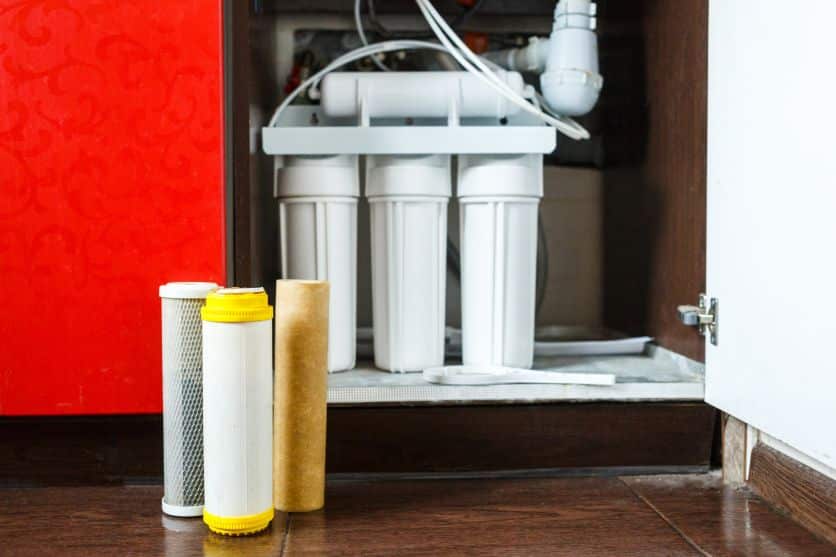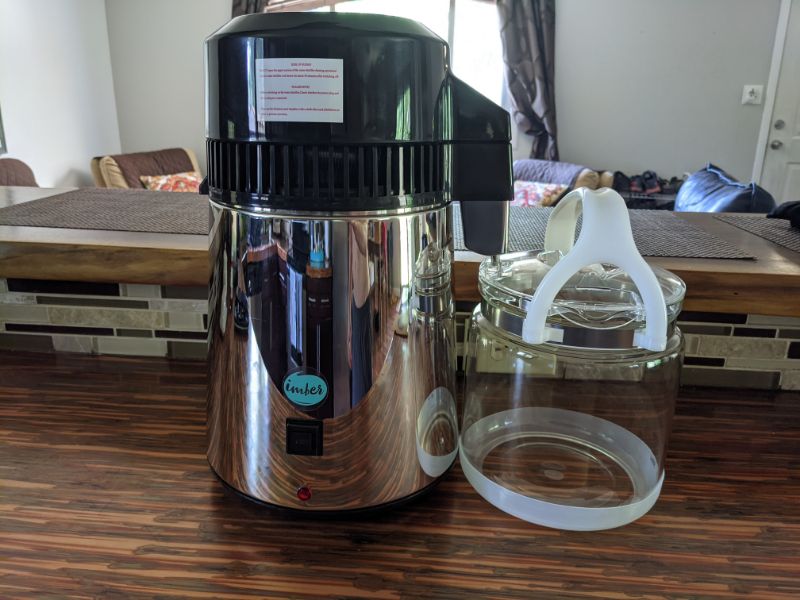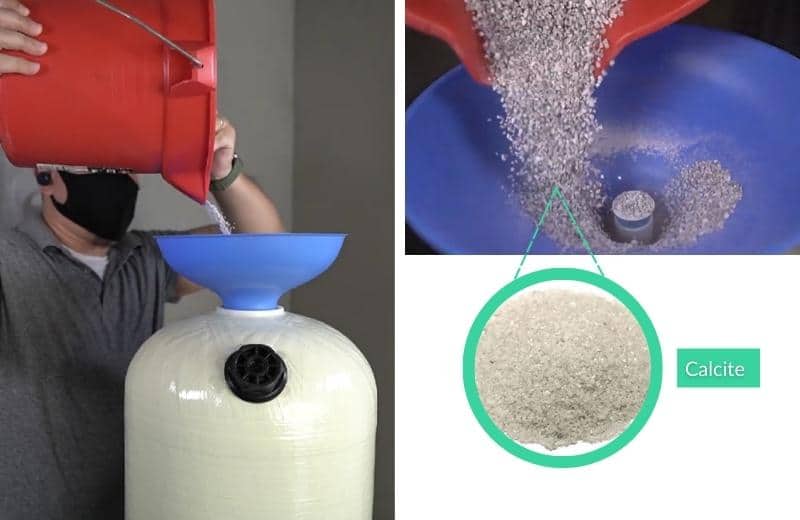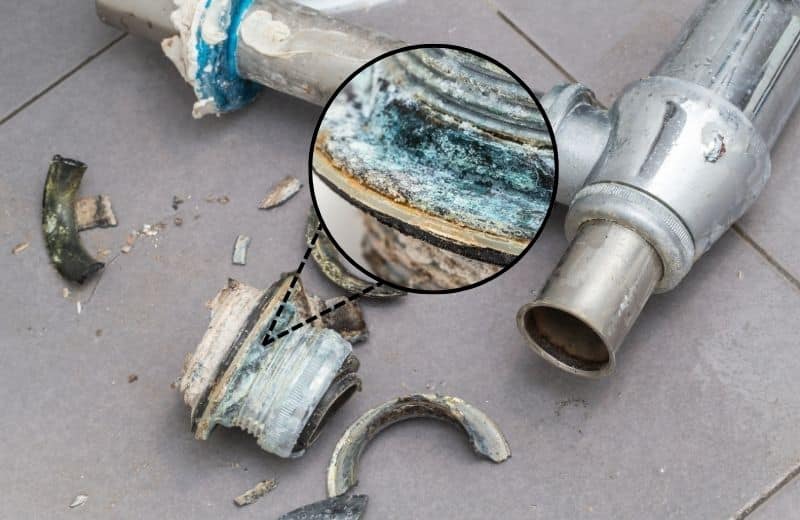Copper is a mineral that we all need to stay healthy – but it’s possible to have too much of a good thing. If your drinking water contains high levels of copper, and you’re exposed to a lot of copper in your environment, you might end up with copper toxicity.
In this guide, we’ve shared the best methods to get rid of copper in drinking water.
📌 Key Takeaways
- The best methods to remove copper from water are reverse osmosis, ion exchange, distillation, acid neutralizer systems, and KDF filters.
- Ceramic filters, activated carbon filters, and sediment filters usually CAN’T remove or reduce copper in drinking water.
- Copper is good for us in low levels, but too much copper has known adverse effects on human health.
Table of Contents
🚰 Best Methods To Remove Copper From Water
Below, we’ve shared the best ways to remove or reduce copper from your drinking water supply.
Reverse Osmosis Systems
Reverse osmosis systems offer an incredibly thorough filtration process that removes virtually everything from your water.
A good reverse osmosis system can remove 97-98% of dissolved copper in drinking water.
Reverse osmosis works by sending water through several filtration stages, including a sediment filter, two carbon filters, and a semipermeable membrane.
The membrane has tiny pores (usually 0.0001 microns) and rejects the majority of dissolved solids, including copper.
A reverse osmosis water filter is most commonly installed as a countertop or under-sink unit. Some point of entry systems are available, but they’re expensive.
Here are the most efficient Reverse Osmosis Systems reviewed by WFG.

Ion Exchange Filters
Ion exchange filters exchange certain ions with those that don’t cause problems in drinking water supplies.
The most common example of ion exchange is a water softener. Water softeners mostly remove calcium and magnesium ions, but they can also remove small amounts of copper in water.
However, the best ion exchange filter for copper removal is a deionization system, which removes all positively and negatively charged ions from tap water. Copper is a positively charged ion, so it should be effectively removed in a deionized water system.
Most deionizers are countertop units that treat batches of water.
Distillation Systems
Distillation is another effective way to remove up to 99.9% of all impurities from water, including copper.
A water distiller boils water until it evaporates, then condenses the water into a separate container. Most impurities, including copper, are unable to evaporate with water, so they’re left behind in the boiling chamber.
Water distillers are free-standing countertop units that require electricity to operate.
Read about our top water distiller recommendations.

KDF Filters
Certain types of KDF filters, including KDF-C, KDF 55, and KDF 8s filters, are capable of removing up to 98% of positively charged ions, including copper, nickel, lead, mercury, and chromium.
KDF filters use a redox reaction to transfer electrons between molecules, creating new elements. Harmful contaminants are changed into harmless impurities, or react to stick to the surface of the filter media.
KDF filters are commonly found in whole home water filters, under-sink systems, and countertop filter units.
Bonus System: Acid Neutralizers
Our bonus recommendation for addressing copper in drinking water is an acid neutralizer, such as a soda ash system.
📌 Acid neutralizers don’t actually reduce copper in water – BUT they neutralize acidic water. If you have copper pipes and water with a low pH, the acidic water will dissolve copper from your pipes and fixtures.
The best way to prevent this copper contamination is by installing a whole home acid neutralizing system.
Check out our reviews of the best acid neutralizer systems.

⛔️ Which Water Filters CAN’T Remove Copper From Water?
There are a few filter types that can’t remove copper from drinking water:
- Sediment Filters – Most sediment filters can’t remove copper because their pores are too big. While sediment filters can trap flakes of heavy metals, like rust, they don’t remove dissolved metals.
- Activated Carbon – On their own, activated carbon filters can’t pull free copper particles out of water. They need to be combined with another filter type to remove these contaminants.
- Ceramic Filters – Again, ceramic filters alone can’t remove copper or any other heavy metals – they’re often combined with ion exchange resin for this purpose.
🔎 What Is Copper?
Copper is a metal that occurs naturally in the environment. It’s an essential trace element, which means we need very small amounts of it to stay healthy.
In low levels, copper is needed for several important bodily functions, including maintaining nerve cells and immune system health, and making red blood cells.
However, excess copper in water could be dangerous.
📥 How Does Copper Get Into Water?
Copper may get into water due to natural groundwater leaching. Copper is present in rocks and soils, so water seeping into an underground aquifer may pick up low levels of this metal.
However, a much more common source of copper ions in water is copper piping, especially in regions with acidic or soft water.
When drinking water with a low pH flows through copper pipes, some of the copper dissolves into the water.
Signs of copper contamination in water include bitter, metallic-tasting water and blue-green stains in your sinks, showers, and bathtubs. You might also notice green corrosion on the outside of your pipes if you have copper plumbing.
Your hot water pipes are likely to be more corroded than cold water pipes, since hot water causes more copper to be released from copper pipes than cold water.

🩺 What Are the Health Effects of Drinking Copper?
The Environmental Protection Agency (EPA) enforces a Maximum Contaminant Level Goal (MCLG) of 1.3 mg/L of copper in water to protect against human health effects from excess copper consumption.
How exactly does copper affect health? If you consume high levels of copper in the long term, you may experience copper toxicity, which causes health problems including:
- Diarrhea
- Muscular weakness and convulsions
- Anemia
- A metallic taste in your mouth
- Kidney problems
- Pain in your abdominal area
- Fever and chills
📝 Final Word
If you’re concerned about the potential health effects of copper in your water, there’s a simple solution: test your water and install a filter (if necessary) to remove this contaminant.

You can also limit your copper exposure by avoiding copper-containing foods, like meats (especially organ meats), dairy products, seeds and nuts, grains, legumes, and tofu. Don’t use cooking utensils made from copper, as these may leach harmful amounts of the metal into your foods.
Remember, though, low levels of copper are good for us, so you don’t want to cut copper out of your diet entirely.
❔ Removing Copper From Water: FAQ
Does boiling water get rid of copper?
No, boiling water isn’t an effective method of copper removal. In fact, you may end up with a higher concentration of copper per gallon of water because boiling causes some of the water to evaporate. You can remove residual chlorine and kill microorganisms by boiling water, but that’s it. The only effective way to get rid of copper is with a water filter.
How do I fix too much copper in my well water?
The best way to fix too much copper in your well water is to install a whole home filtration system that removes this contaminant. Buy a well water filtration system that can remove heavy metals, or consider a point of use filter to address copper in drinking water.
Can a water softener remove copper?
Yes, a water softener can remove low copper concentrations in water. However, the best way to remove excess copper is with a dedicated water filter. Distillation systems, reverse osmosis filters, and KDF filters are all good ways to address this naturally occurring metal.
What happens if you drink water with copper in it?
Nothing will happen if you drink from a water supply with low copper levels. However, higher concentrations of copper may have toxic effects including diarrhea, fever, anemia, and a metallic taste in your mouth.

